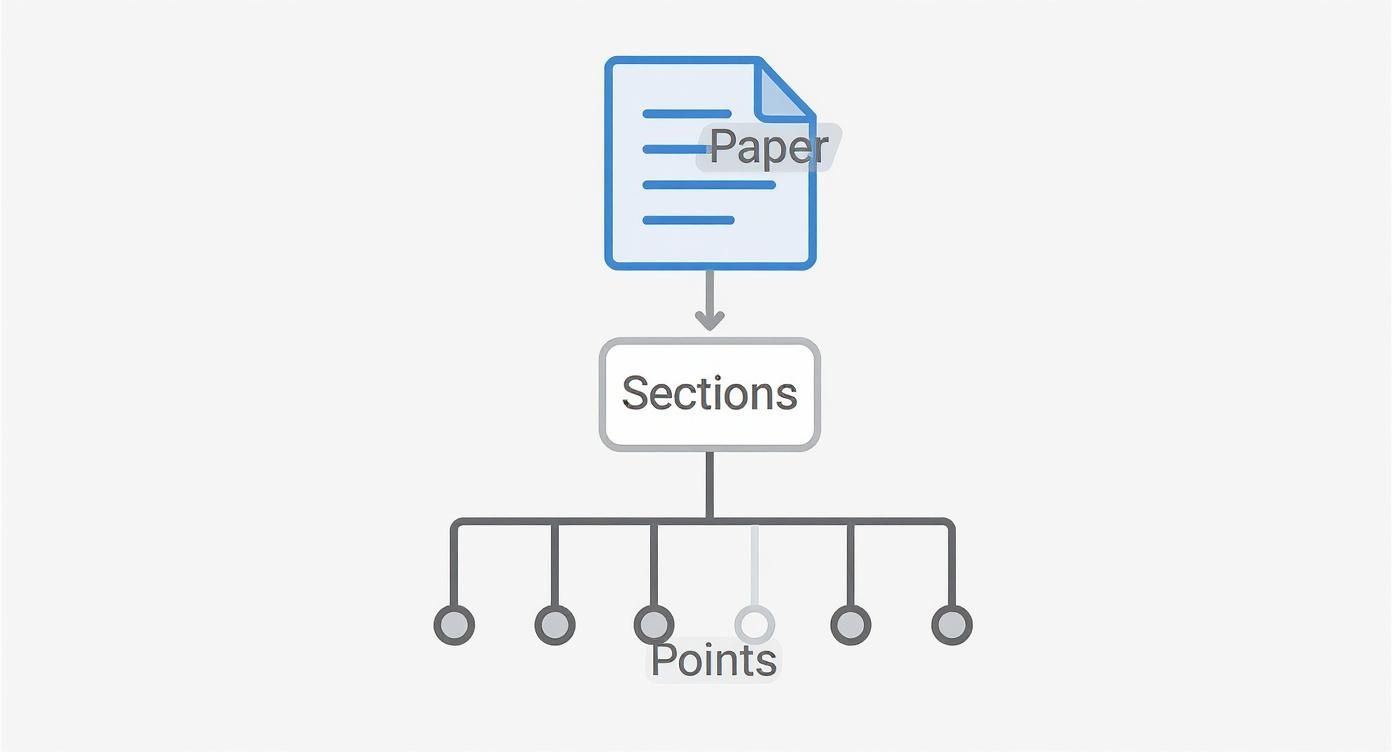
how to write outline for research paper: quick guide
October 22, 2025
Staring at a blank page for a research paper can feel like trying to scale a mountain without a map. The gut reaction is to just start writing and hope for the best, but that's a recipe for frustration. A better approach? Build a solid plan first.
Think of your outline as the architectural blueprint for your paper. It’s a strategic tool that breaks a massive project into manageable, logical steps, ensuring your arguments flow perfectly from introduction to conclusion.
Why a Research Paper Outline Is Your Secret Weapon

Let's be honest—many students, and even some seasoned academics, see outlining as a tedious chore. But what if you saw it as your most powerful tool against a blank screen? A good outline is exactly that. It's a built-in guide that gives you clear direction and helps implement strategies to overcome writer's block because you always know what comes next.
An outline forces you to think critically about your topic before you commit a single paragraph to the page. It’s the space where you organize your messy thoughts, structure your arguments, and figure out exactly what evidence you need to back up your claims. This isn’t just about making a list; it’s about building a rock-solid logical foundation.
The Strategic Advantages of Planning Ahead
That bit of time you invest upfront in a detailed outline? It pays off big time, saving you hours of painful rewrites later. It helps you spot gaps in your research early, making sure you have enough evidence for every point you want to make.
A well-organized structure also keeps you laser-focused on your thesis statement. It acts as a guardrail, preventing those tempting but irrelevant tangents that can weaken your entire argument.
The benefits of creating a strong outline are immediate and incredibly practical. It's not just about organization; it's about making the entire writing process smoother and more effective.
Immediate Benefits of a Well-Crafted Outline
| Benefit | Impact on Your Writing Process |
|---|---|
| Logical Flow | Your ideas connect seamlessly, guiding the reader through your reasoning without any confusing jumps or gaps. |
| Improved Cohesion | Every section and paragraph has a clear purpose, directly supporting and strengthening your central argument. |
| Efficient Writing | You're not starting from scratch each time you sit down. You’re simply expanding on a pre-built, well-thought-out structure. |
| Early Gap Detection | You can identify weak points or areas needing more research before you've written hundreds of words around them. |
Ultimately, a good outline is the difference between a rambling paper and a compelling, persuasive one.
A great outline doesn't just list topics; it maps the journey of your argument. It shows you where you're going, how you'll get there, and what evidence you'll use to prove your point along the way.
In an academic world that's more competitive than ever, clarity is king. Your ideas need to cut through the noise. A clear, well-structured paper is how you do it. For a deeper dive, check out our guide on https://naturalwrite.com/blog/what-is-an-outline-of-a-research-paper.
In the end, learning how to write an outline for a research paper isn’t about following a rigid formula. It’s about creating a personalized roadmap that turns a daunting project into an achievable goal, giving you the confidence to write a paper that truly makes an impact.
Gathering the Building Blocks for Your Outline

Before you can even think about Roman numerals or indented bullet points, you need the raw materials. A strong outline for a research paper isn't pulled out of thin air; it’s built on a solid foundation of information you've already gathered and sorted. This is where the real work of shaping your argument begins.
Think of it like being a detective. You're out there collecting clues, looking for patterns, and piecing together a case. If you rush this part, the final structure will be flimsy and unconvincing. You can't build a house without bricks, right?
From Research Question to Thesis Statement
Every great research paper revolves around a clear, debatable thesis statement. This isn't just a topic—it's your core argument, boiled down into one powerful sentence. It’s the North Star that guides every single decision you make from here on out.
To find it, you have to start with a broad research question. Maybe you begin with something like: "How does remote work affect employee productivity?" It's a decent start, but it's way too general.
This is where your initial research comes in. As you read articles and studies, you'll start noticing specific trends or conflicting data. That's your cue to narrow things down and take a stance.
- Initial Question: "How does remote work affect employee productivity?"
- Refined Thesis Statement: "While remote work offers increased flexibility, it leads to a measurable decline in collaborative innovation among tech-sector employees due to reduced spontaneous interaction."
See the difference? This new thesis is specific, someone could argue against it, and it gives you a clear roadmap for your outline. Now you know exactly what you need to prove.
Organizing Your Research and Evidence
With a thesis in hand, your next job is to organize all the evidence that will back it up. A messy pile of articles and random notes is a recipe for chaos. Good organization is absolutely essential for building a coherent outline.
A great way to start is by grouping your notes and sources by theme. Instead of just making a long list of what you've read, create thematic buckets that align with the main parts of your thesis. For that remote work example, your categories might look like this:
- Studies on individual productivity metrics
- Data on collaborative project outcomes
- Research on workplace communication patterns
- Employee surveys on job satisfaction vs. innovation
When you organize your research thematically, it becomes much easier to spot where your arguments are solid and where you might need to dig for more evidence. You'll also start to see the major sections of your paper taking shape.
Pro Tip: As you gather information, document everything meticulously. Not only does this save you from the headache of hunting for a source later, but it's also a fundamental part of academic integrity. For a deeper dive, check out our guide on how to avoid plagiarism and keep your writing ethical.
Identifying Key Supporting Points
Once your research is sorted into themes, go through each category and pull out the most powerful evidence. You're looking for statistics, compelling quotes, case studies, or expert opinions that directly support your thesis. These are the supporting points that will flesh out your outline.
For each major theme, try to find two or three key pieces of evidence. For example, under "Data on collaborative project outcomes," you might find:
- A study showing a 15% decrease in cross-departmental projects after companies went fully remote.
- An expert quote from a tech CEO about the loss of "water cooler" brainstorming.
- A case study of a company that used virtual collaboration tools to fight this decline.
These concrete data points are the building blocks you’ll slot into your outline. Having them ready transforms outlining from a dreaded chore into a straightforward assembly process. With your thesis sharp and your evidence organized, you're ready to build a powerful research paper outline.
Alright, you've got your thesis statement nailed down and your research is organized. Now comes the fun part: building the actual structure. This is where you take that messy pile of ideas and forge it into a logical, hierarchical plan.
Knowing how to outline a research paper isn't about blindly following a template. It's about understanding how arguments are built, piece by piece, from the ground up.
The whole game is to work from the top down. Start with the big, universal sections of any research paper, and then slice them into smaller, more specific points. This approach guarantees that every detail you include has a clear purpose and ties directly back to your main argument.
Choosing Your Outline Format
Before you start plugging in details, you need to decide on a format. The two most common systems are the alphanumeric and the decimal outline. Honestly, neither is "better" than the other—it usually just comes down to personal preference or what your professor or institution requires.
- Alphanumeric Outline: This is the classic format you probably remember from high school. It uses a mix of Roman numerals, capital letters, Arabic numerals, and lowercase letters to show the hierarchy. It's super intuitive and works great for most papers.
- Decimal Outline: This format uses a system of numbers (like 1.0, 1.1, 1.1.1) to mark each level. It's extremely logical and often the go-to in technical or scientific fields where you need intense precision and complex sub-sections.
For most academic writing, the alphanumeric format is more than enough. It's easy for you to write and, more importantly, easy for your reader to follow.
To make the choice clearer, here’s a quick comparison of how the two stack up.
Comparing Alphanumeric and Decimal Outline Formats
This table breaks down the core differences to help you pick the right tool for your specific project.
| Feature | Alphanumeric Outline | Decimal Outline |
|---|---|---|
| Hierarchy | I. > A. > 1. > a. | 1.0 > 1.1 > 1.2.1 |
| Visual Style | Traditional, easy to scan for major vs. minor points. | Modern, precise, and systematic. |
| Best For | Humanities, social sciences, and general research papers. | Scientific reports, engineering documents, legal texts. |
| Flexibility | Can sometimes feel limited to four levels of detail. | Infinitely expandable for deeply complex subjects. |
Whichever format you land on, the most important thing is consistency. Pick one system and stick with it from start to finish. It’s all about maintaining clarity.
Building From Major Sections Downward
Every research paper, regardless of the field, follows a pretty standard structure. These major sections will become the highest level of your outline—your Roman numerals, if you're going with the alphanumeric system.
The usual suspects are:
- Introduction
- Literature Review / Background
- Methodology
- Results / Findings
- Discussion
- Conclusion
Think of these as the main pillars holding up your entire paper. With those in place, the next job is to flesh out what actually goes inside each one.
Detailing Each Section with Subpoints
Now, let's zoom in and break down a major section to see how this works in the real world. We'll use the Introduction as our example. A common mistake is just writing "Introduction" on the outline and calling it a day. A great outline deconstructs it.
Instead of a single placeholder, a properly detailed introduction outline should look more like this:
I. Introduction
A. The Hook: Grab the reader's attention right away with a compelling statistic, a short anecdote, or a provocative question.
1. Example Stat: Mention the dramatic increase in remote work post-2020.
B. Background Context: Give just enough background for your reader to understand the problem you're addressing.
1. Explain the historical shift from office-centric to hybrid models.
2. Note the ongoing debate about productivity and innovation.
C. Thesis Statement: State your central argument clearly and without any fluff.
1. Our thesis: "While remote work offers flexibility, it leads to a measurable decline in collaborative innovation..."
D. Roadmap: Briefly tell the reader what to expect in the rest of the paper.
By breaking down just one section this way, you’ve created a mini-guide for yourself. When you finally sit down to write, you're not staring at the terrifying task of "writing the intro." You're just tackling small, manageable pieces. As you shift from collecting ideas to structuring them, adopting solid knowledge management best practices can make this whole process a lot smoother.
An outline is really just a conversation with yourself about your paper's logic. Each level of detail you add is another question answered, another connection made. It’s how you make sure your final argument is seamless and persuasive.
In recent years, outlining has become even more critical as academic research gets more complex. We're seeing huge global trends—climate change, demographic shifts, technological disruption—that force scholars to tackle interdisciplinary challenges. A detailed outline is the tool that helps researchers navigate this complexity, making sure their work is structured, impactful, and relevant.
Ultimately, the goal is to create an outline so detailed that writing the paper feels more like connecting the dots than starting from scratch. The more thought you put into the structure now, the faster and more powerfully you’ll write the final draft.
Practical Outline Templates for Different Disciplines
A research paper's structure isn't a one-size-fits-all deal. What works perfectly for a scientific experiment will feel clunky and out of place in a historical analysis or a literary critique. Different fields ask different questions, and that means they need unique ways of presenting evidence.
This is why knowing how to write an outline for a research paper really means knowing which template to reach for. Instead of jamming your ideas into a rigid box, you can pick a framework that actually fits your topic and field of study.
The infographic below breaks down the basic hierarchy of any good research paper, showing how broad sections get drilled down into smaller, more specific points.

As you can see, a powerful outline moves from general concepts to specific evidence. It creates a clear, logical path for your reader to follow.
The IMRaD Format for Scientific Papers
For empirical research in the sciences and social sciences, the IMRaD format is the gold standard. It’s an acronym for Introduction, Methods, Results, and Discussion. This structure is so effective because it mirrors the scientific process itself: you state a problem, explain how you studied it, report what you found, and then interpret those findings.
A classic IMRaD outline looks something like this:
- I. Introduction:
- A. Background on the research problem
- B. Identification of a specific gap in current knowledge
- C. Research question and hypothesis
- II. Methods:
- A. Description of study design (e.g., experimental, correlational)
- B. Profile of participants or subjects
- C. Detailed procedure of data collection
- D. Explanation of data analysis techniques
- III. Results:
- A. Presentation of key findings without interpretation
- B. Use of tables and figures to display data
- C. Statistical outcomes (e.g., p-values, confidence intervals)
- IV. Discussion:
- A. Interpretation of the results in the context of the hypothesis
- B. Comparison of findings with existing literature
- C. Acknowledgment of study limitations
- D. Implications for future research and practical application
This format creates a clean, reproducible narrative that lets other researchers understand and build on your work. It just makes sense.
A Narrative Structure for Humanities Research
Humanities papers—think history, literature, or philosophy—don't usually rely on empirical data. Instead, they build arguments through interpretation and thematic analysis. So, the outline needs to reflect this more narrative, thesis-driven approach.
Here, the structure is more flexible and is built entirely around the core argument you're trying to prove.
In the humanities, your outline isn't just a container for data; it's the very architecture of your argument. Each section should be a deliberate step that moves the reader closer to accepting your thesis.
For a literary analysis paper, a template might look like this:
- Introduction:
- Introduce the literary work and author.
- Provide brief context relevant to your argument.
- Present your interpretive thesis statement (e.g., "In The Great Gatsby, the green light symbolizes the unattainable nature of the American Dream, not just Gatsby's love for Daisy.")
- Thematic Section 1: Establishing the Symbol:
- Analysis of early appearances of the green light.
- Textual evidence (quotes) showing its connection to Daisy.
- Thematic Section 2: Broadening the Symbol's Meaning:
- Connecting the light to themes of wealth, ambition, and the past.
- Evidence from Nick Carraway's narration.
- Thematic Section 3: The Symbol's Ultimate Failure:
- Analysis of the final scenes and the symbol's fading significance.
- How this reinforces the critique of the American Dream.
- Conclusion:
- Summarize the argument's progression.
- Restate the thesis in a new light, highlighting its broader implications for understanding the novel.
This structure allows you to build a persuasive case, brick by brick, using textual evidence to support each stage of your interpretation.
A Comparative Framework for a Literature Review
A literature review is a different beast altogether. Your goal isn't to present new data, but to synthesize and evaluate what other researchers have already done. Because of this, its outline has to be organized to highlight trends, gaps, and debates in the field. To get a deeper dive, check out our in-depth guide on how to write a literature review.
Simply summarizing sources in chronological order is rarely the best way to go. A thematic or comparative approach is almost always stronger.
- I. Introduction:
- A. Define the topic and its significance.
- B. State the scope of the review (e.g., time period, disciplines included).
- C. Present the organizational pattern of the review.
- II. Thematic Cluster 1: Foundational Theories:
- A. Summarize and critique seminal works in the field.
- B. Discuss the initial theoretical frameworks.
- III. Thematic Cluster 2: Emerging Methodological Debates:
- A. Compare and contrast different research approaches (e.g., qualitative vs. quantitative studies on the topic).
- B. Highlight key disagreements among scholars.
- IV. Thematic Cluster 3: Current Trends and Applications:
- A. Synthesize the most recent research.
- B. Discuss how the research is being applied in practice.
- V. Conclusion:
- A. Summarize the major patterns and gaps identified.
- B. Suggest directions for future research.
When you choose the right template from the start, you're giving your ideas the best possible structure to shine through.
Advanced Outlining Techniques and Pro Tips
Once you've nailed down the basic structure, you can start treating your outline as more than just a static checklist. Think of it as a dynamic tool that grows and changes with your project. This is where you flip the script and make the outline work for you, not the other way around.
Advanced outlining is really about being flexible. A good research paper is a living thing, and your plan needs to breathe and adapt as you dig up new information or sharpen your arguments.
Choosing Your Outlining Arsenal
First things first: pick the right tool for the job. While a simple word processor gets you there, some dedicated outlining software can be a lifesaver on more complex projects.
- Traditional Tools (Word, Google Docs): Everyone has them, and they're easy to use. They're perfect for straightforward alphanumeric outlines where you just need to get the job done without any fuss.
- Specialized Software (Scrivener, Notion): These platforms are built from the ground up for writers. Scrivener lets you break your paper into tiny, manageable pieces that you can drag and drop around. Notion is more like a flexible database, where you can tag sources, link ideas, and track everything in a way that isn't just a straight line.
So, which one should you choose? It really comes down to the scale of your project. For a standard five-page essay, Google Docs is all you need. But if you're staring down a dissertation, learning Scrivener could honestly save you dozens of hours.
The Power of the Reverse Outline
One of the most powerful editing techniques I know has nothing to do with grammar—it's the reverse outline. Instead of planning what you’re going to write, you create an outline from what you've already written.
It's a total game-changer for checking if your paper actually makes sense. Just go through your finished draft and, for each paragraph, jot down its main point in a single sentence. Then, take a hard look at that new list you just made.
A reverse outline is like an X-ray of your paper's structure. It immediately shows you where your argument is solid, where you start repeating yourself, or where you've gone completely off the rails.
Does the flow of your points feel logical? Are some paragraphs trying to do too much at once? Does the body of your paper actually support the thesis you started with? This forces you to be honest about the structure you have, not just the one you intended to create.
Keeping Your Outline Flexible and Collaborative
A great outline is never set in stone. As you write, you're going to get new ideas. You'll find new evidence. Your outline needs to be a place where you can slot these new discoveries in without blowing up your entire project.
This is especially true if you’re working with a team. Today, outlining a research paper is all about technology. Collaborative platforms and AI-powered writing tools have completely changed the game, allowing teams to work together seamlessly from anywhere in the world. You can discover more insights about these global trends and how they're shaping modern research.
To keep your outline nimble and team-friendly, try these tips:
- Use a Cloud-Based Document: Tools like Google Docs or Notion are built for this. Everyone can jump in and see changes in real-time.
- Add a "Parking Lot" Section: I always create a space at the bottom of my outline for random ideas that don't quite fit yet. This way, good thoughts don't get lost, but they also don't clutter up the main structure.
- Track Your Progress: Use your outline as a to-do list. I like to highlight or color-code sections as I finish them. It’s a simple visual that shows how far you've come and helps you stay motivated, especially during a long haul.
Sticking Points & Common Questions About Outlines
Even the best-laid plans run into snags. It’s totally normal to have questions pop up while you're wrestling with your outline—in fact, it's a sign you're thinking critically about your project. Let's walk through some of the most common hangups to get you unstuck and back on track.
"How Detailed Does This Thing Actually Need to Be?"
This is, without a doubt, the number one question I hear. And the honest answer is: it depends. A quick five-page essay probably only needs a simple one-page topic outline. A dissertation, on the other hand, might demand a super-detailed, multi-page sentence outline to keep everything straight.
Here's a good rule of thumb: your outline should be detailed enough that you could explain your paper's entire argument to someone just by reading it to them. If you can see the logical flow without having to fill in any gaps, you're golden.
Practically, this means every major point should have its key supporting evidence listed right underneath it. No guesswork needed.
"What If My Research Completely Wrecks My Thesis?"
Another classic. You’re digging through sources, and you find a study that pokes a huge hole in your original argument. First off, don't panic. This is actually a good thing. It means you're genuinely engaging with your topic, not just looking for evidence that confirms what you already believe.
Your outline is a map, not a contract set in stone. It's meant to be flexible.
Here’s what you can do:
- Tweak Your Thesis: The best move is usually to adjust your thesis statement to account for this new information. This doesn’t weaken your paper; it makes your argument more sophisticated and defensible.
- Shuffle Your Sections: You might need to move things around. Maybe a sub-point becomes a main point, or you need a whole new section to deal with this new angle. That’s what outlines are for.
- Embrace the Counterargument: Use that conflicting evidence! Build a section that directly addresses counterarguments. Acknowledging and refuting opposing views is a hallmark of strong academic writing.
The key is to let your outline grow and change as your understanding deepens. It’s a living document.
"Can I Jump Around and Write Sections Out of Order?"
Yes! Please do. In fact, for most people, it's a much smarter way to work. Staring at a blank page and trying to write the perfect introduction is one of the fastest ways to get stuck. How can you introduce something you haven't fully written yet?
Once you have a solid outline, you can see all the component parts of your paper laid out clearly. This gives you the freedom to start where you feel the most confident. Many writers jump straight into the methodology or results sections because they're just reporting the facts.
Knocking out these more straightforward parts first builds momentum. It makes tackling the trickier introduction and conclusion feel a whole lot less intimidating later on.
After you've built your outline and hammered out a draft, the final polish is what makes it shine. Natural Write can help you transform any text that sounds a bit stiff or robotic into a polished, readable piece. Instantly refine your writing and move past AI detectors with confidence at https://naturalwrite.com.


